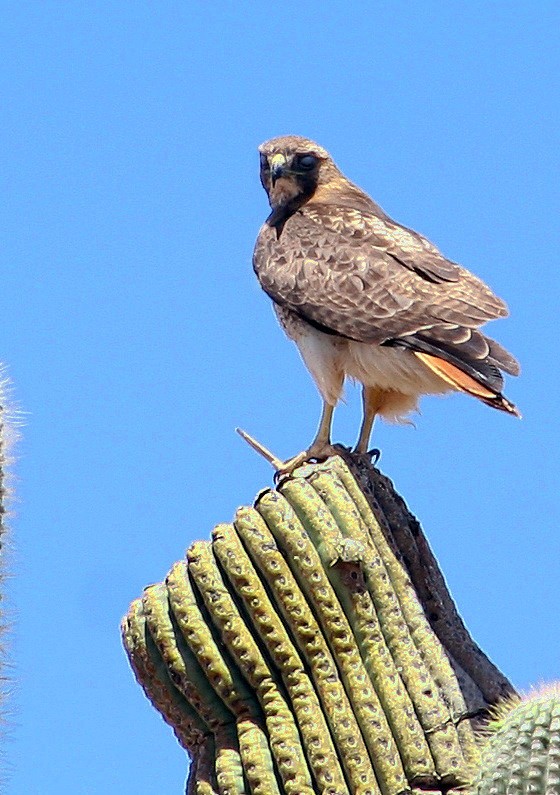Red-tailed Hawk
A species of Buzzards and Buteo Hawks, Also known as Chicken Hawk, Hen Hawk Scientific name : Buteo jamaicensis Genus : Buzzards and Buteo Hawks
Red-tailed Hawk, A species of Buzzards and Buteo Hawks
Also known as:
Chicken Hawk, Hen Hawk
Botanical name: Buteo jamaicensis
Genus: Buzzards and Buteo Hawks
Description
Perched high in trees, the red-tailed Hawk watches for its prey: mammals, reptiles, birds, amphibians, large insects, and occasionally fish. It's the most common hawk in North America. Highly territorial and monogamous, the red-tailed Hawk is relatively long-lived. Many of them die young, but those who survive can live up to 20 years.
Size
48 - 35 cm
Life Expectancy
29.5 years
Nest Placement
Tree
Clutch Size
1 - 5 eggs
Incubation Period
1 brood
Number of Broods
28 - 35 days
Nestling Period
42 - 46 days
Feeding Habits
Red-tailed Hawk primarily consumes mammals including voles, mice, various rats, rabbits, hares, and squirrels. Its diet also encompasses birds like pheasants and blackbirds, as well as reptiles, fish, amphibians, invertebrates, and occasionally carrion. Highly opportunistic, red-tailed Hawk preys on animals ranging from less than an ounce to over 5 pounds.
Habitat
Red-tailed Hawk are highly adaptable birds, thriving in diverse open habitats across North and Central America. These include deserts, scrublands, grasslands, and agricultural landscapes with mixed forest and field. Red-tailed Hawk favor environments that provide high perching and nesting sites, such as trees, bluffs, or streamside groves. Urban areas with parks and roadside fields also serve as suitable habitats. From sea level to mountainous regions, red-tailed Hawk are versatile in both temperate and tropical climates, including Mexico's rainforests.
Nest Behavior
Red-tailed Hawk takes 4-7 days to build or refurbish nests, with both members contributing. They demonstrate a strong preference for previous nesting sites.
Nest Characteristics
Red-tailed Hawk's nests are often located in tall tree crowns, cliff ledges, or on man-made structures. They are built from dry sticks and can reach up to 6.5 feet high and 3 feet in diameter, with a lining of bark, foliage, and vegetation.
Dite type
Carnivorous
People often ask
Migration Overview
Red-tailed hawks are considered partial migrants, as in about the northern-third of their distribution, which is most of their range in Canada and Alaska, they almost entirely vacate their breeding grounds. In coastal areas of the north, however, such as in the Pacific northwest up to southern Alaska and in Nova Scotia on the Atlantic, red-tailed hawks do not usually migrate. More or less, any area where snow cover is nearly continuous during the winter months will show an extended absence of most red-tailed hawks, so some areas as far south as Montana may show strong seasonal vacancies of red-tails.
General Info
Feeding Habits
Bird food type
Bird Feeder Type

Ground
Behavior
Red-tailed Hawk typically engage in behaviors such as soaring on warm air thermals, hunting for prey during the day by keenly observing from high perches or in flight, and defending their territories with determination. Courting red-tailed Hawk exhibit unique aerial displays, including talon-locking acrobatics. These birds prioritize maintaining a strong bond with their partners, usually remaining monogamous until one of them perishes. Their interaction with the environment is primarily characterized by their role as apex predators, controlling the population dynamics of their prey species within their habitat.
Distribution Area
The red-tailed hawk is one of the most widely distributed of all raptors in the Americas. It occupies the largest breeding range of any diurnal raptor north of the Mexican border, just ahead of the American kestrel (Falco sparverius). The red-tailed hawk breeds from nearly north-central Alaska, the Yukon, and a considerable portion of the Northwest Territories, there reaching as far as a breeder as Inuvik, Mackenzie river Delta and skirting the southern shores of Great Bear Lake and Great Slave Lake. 
